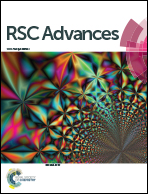Stable high-rate cycling electrode based on Li3V2(PO4)3/C using polyamide as a novel carbon source†
Abstract
Polyamide, as a novel carbon source, was introduced for the first time into the synthesis of Li3V2(PO4)3/C cathode materials for lithium ion batteries through a carbon-thermal reduction method. The influence of different sintering temperatures on crystal structure, morphology and electrochemical performance of the Li3V2(PO4)3/C composites was investigated by X-ray diffraction, scanning electron microscopy, transmission electron microscopy and electrochemical tests. XRD results indicate that as-prepared Li3V2(PO4)3 is a well crystallized single phase without any impurity phase. SEM and TEM observation demonstrates that a uniform carbon layer with a thickness of about 2–3 nm is coated on Li3V2(PO4)3 particles. The optimal Li3V2(PO4)3/C composite synthesized at 800 °C exhibits a specific capacity of 125.5 mA h g−1 at 1C rate and 94.7% capacity retention when the rate increases from 1C to 10C, presenting a good rate capability. The cross-linking effect of residual carbon from decomposed polyamide plays a critical role in decreasing electron transfer resistance and improving the lithium ion diffusion behavior in Li3V2(PO4)3 particles.


 Please wait while we load your content...
Please wait while we load your content...